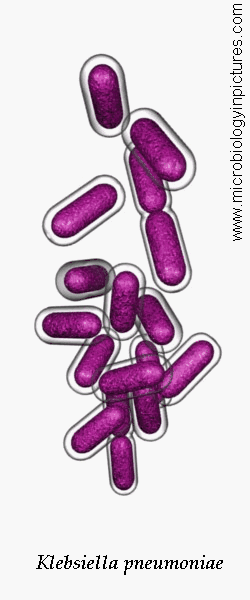Klebsiella pneumoniae


Three different strains of Klebsiella pneumoniae on Endo agar with biochemical slope (see here).
Klebsiella pneumoniae
is urea positive (blue color of the slope), metabolise glucose with production of gas (bubbles under a piece of glass -
in detail left down side of each plate) and is lactose positive (but on Endo agar its colonies often remain quite pale).
Unlike some similarly looking strains of Enterobacter cloacae is K. pneumoniae lysine "+", ornithine "-", arginine "-"
(E. cloacae lysine "-", ornithine "+", arginine "+").
Klebsiella pneumoniae is a Gram-negative,
non-motile, encapsulated, lactose fermenting, facultative anaerobic, rod shaped bacterium found in the normal flora of the intestines.
It is clinically the most important member of the Klebsiella genus of Enterobacteriaceae. It naturally occurs in the soil and about 30% of strains can fix nitrogen in anaerobic condition.
As a general rule, Klebsiella infections tend to occur in people with a weakened immune system. Many of these infections are obtained when
a person is in the hospital for some other reason (a nosocomial infection).
The most common infection caused by Klebsiella bacteria outside the hospital is pneumonia.
New antibiotic resistant strains of K. pneumoniae are appearing, and it is increasingly found as a nosocomial infection. Klebsiella ranks second to E. coli for urinary tract
infections in older persons. It is also an opportunistic pathogen for patients with chronic pulmonary disease, enteric pathogenicity, nasal mucosa atrophy, and rhinoscleroma. Feces are the
most significant source of patient infection, followed by contact with contaminated instruments.
Klebsiella pneumoniae basic characteristics
- GRAM-NEGATIVE RODS
- NON-MOTILE
- NON-SPORE-FORMING
- CATALASE: POSITIVE
- OXIDASE: NEGATIVE
- FACULTATIVELY ANAEROBIC
Tests for identification of Klebsiella pneumoniae
| MacConkey growth |
Indole production |
Methyl red |
Voges- Proskauer |
Citrate (Simmons) |
Hydrogen sulfide(TSI) |
Urea hydrol. |
Lysine decarb. |
Arginine dihydrol. |
Ornithine decarb. |
| POS. | NEG. | NEG. | POS. | POS. | NEG. | POS. | POS. | NEG. | NEG. |
| Motility (36 °C) |
D-glucose acid/gas |
D-mannitol ferm. |
Sucrose ferm. |
Lactose ferm. |
D-sorbitol ferm. |
Cellobiose | Esculin hydrol. |
Acetate utiliz. |
ONPG test |
| NEG. | POS./POS. | POS. | POS. | POS. | POS. | POS. | POS. | D | POS. |
- POS. positive ( > 90% of strains are positive)
- D most positive (51 - 89%)
- d most negative (11 - 50%)
- NEG. negative (0 - 10%)
- trimethoprim-sulfamethoxazole
- cephalosporines (second and third generation)
- tetracyclines
- aminoglycosides
- amoxicillin/clavulanic acid
- ampicillin/sulbactam
- fluoroquinolones
- cephalosporines (second and third generation)
- aminoglycosides
- imipenem/Cilastin
- aztreonam
- colistin
Antibiotic treatment of Klebsiella pneumoniae infections
Uncomplicated urinary tract infections
Alternative
Other infections
Alternative
List of antibiotics (Wikipedia)
Klebsiella pneumoniae colonies on agar cultivation media
Klebsiella pneumoniae on blood agar















Klebsiella pneumoniae on MacConkey












Klebsiella pneumoniae on Endo agar










Klebsiella pneumoniae on CLED agar


Other solid cultivation media for microbiology



Klebsiella pneumoniae sensitivity to antibiotics




Klebsiella pneumoniae identification





Klebsiella pneumoniae Gram-stain


Klebsiella pneumoniae SEM


Useful Links
WIKIPEDIACENTERS FOR DISEASE CONTROL AND PREVENTION (CDC)
- Klebsiella pneumoniae disease
- Carbapenem-resistant Enterobacteriaceae in Healthcare Settings
- CRE Prevention Toolkit
www.antimicrobe.org
Microbe Wiki (the student-edited microbiology resource)
www.vetbact.org
Yuri's blog
